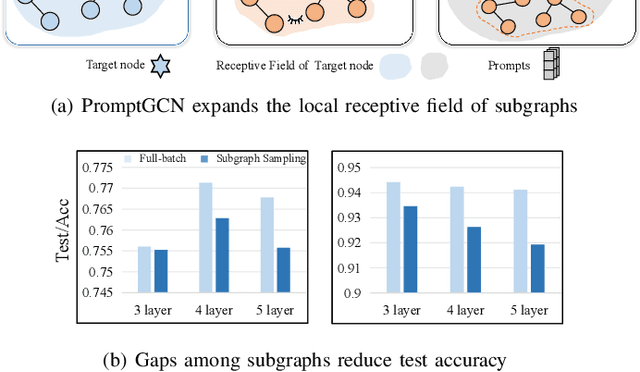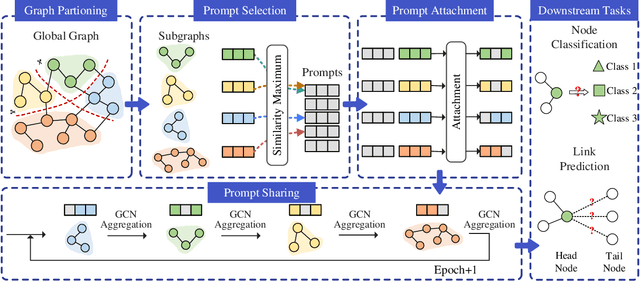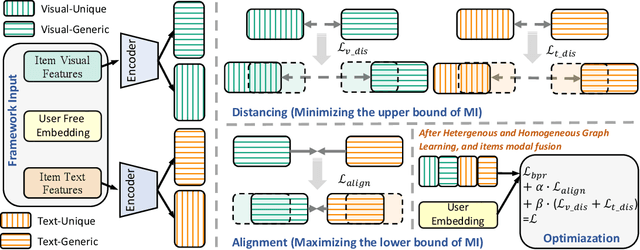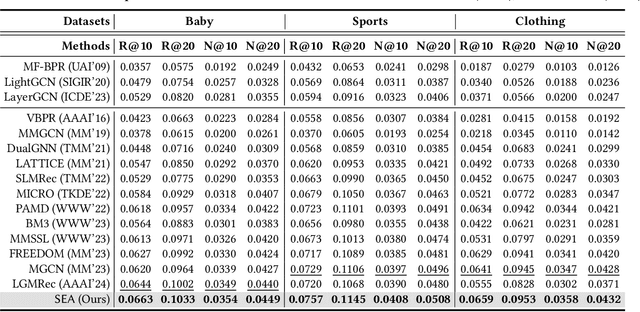Le Wu
MoRE: A Mixture of Low-Rank Experts for Adaptive Multi-Task Learning
May 28, 2025Abstract:With the rapid development of Large Language Models (LLMs), Parameter-Efficient Fine-Tuning (PEFT) methods have gained significant attention, which aims to achieve efficient fine-tuning of LLMs with fewer parameters. As a representative PEFT method, Low-Rank Adaptation (LoRA) introduces low-rank matrices to approximate the incremental tuning parameters and achieves impressive performance over multiple scenarios. After that, plenty of improvements have been proposed for further improvement. However, these methods either focus on single-task scenarios or separately train multiple LoRA modules for multi-task scenarios, limiting the efficiency and effectiveness of LoRA in multi-task scenarios. To better adapt to multi-task fine-tuning, in this paper, we propose a novel Mixture of Low-Rank Experts (MoRE) for multi-task PEFT. Specifically, instead of using an individual LoRA for each task, we align different ranks of LoRA module with different tasks, which we named low-rank experts. Moreover, we design a novel adaptive rank selector to select the appropriate expert for each task. By jointly training low-rank experts, MoRE can enhance the adaptability and efficiency of LoRA in multi-task scenarios. Finally, we conduct extensive experiments over multiple multi-task benchmarks along with different LLMs to verify model performance. Experimental results demonstrate that compared to traditional LoRA and its variants, MoRE significantly improves the performance of LLMs in multi-task scenarios and incurs no additional inference cost. We also release the model and code to facilitate the community.
Invariance Matters: Empowering Social Recommendation via Graph Invariant Learning
Apr 14, 2025Abstract:Graph-based social recommendation systems have shown significant promise in enhancing recommendation performance, particularly in addressing the issue of data sparsity in user behaviors. Typically, these systems leverage Graph Neural Networks (GNNs) to capture user preferences by incorporating high-order social influences from observed social networks. However, existing graph-based social recommendations often overlook the fact that social networks are inherently noisy, containing task-irrelevant relationships that can hinder accurate user preference learning. The removal of these redundant social relations is crucial, yet it remains challenging due to the lack of ground truth. In this paper, we approach the social denoising problem from the perspective of graph invariant learning and propose a novel method, Social Graph Invariant Learning(SGIL). Specifically,SGIL aims to uncover stable user preferences within the input social graph, thereby enhancing the robustness of graph-based social recommendation systems. To achieve this goal, SGIL first simulates multiple noisy social environments through graph generators. It then seeks to learn environment-invariant user preferences by minimizing invariant risk across these environments. To further promote diversity in the generated social environments, we employ an adversarial training strategy to simulate more potential social noisy distributions. Extensive experimental results demonstrate the effectiveness of the proposed SGIL. The code is available at https://github.com/yimutianyang/SIGIR2025-SGIL.
MoLoRec: A Generalizable and Efficient Framework for LLM-Based Recommendation
Feb 12, 2025Abstract:Large Language Models (LLMs) have achieved remarkable success in recent years, owing to their impressive generalization capabilities and rich world knowledge. To capitalize on the potential of using LLMs as recommender systems, mainstream approaches typically focus on two paradigms. The first paradigm designs multi-domain or multi-task instruction data for generalizable recommendation, so as to align LLMs with general recommendation areas and deal with cold-start recommendation. The second paradigm enhances domain-specific recommendation tasks with parameter-efficient fine-tuning techniques, in order to improve models under the warm recommendation scenarios. While most previous works treat these two paradigms separately, we argue that they have complementary advantages, and combining them together would be helpful. To that end, in this paper, we propose a generalizable and efficient LLM-based recommendation framework MoLoRec. Our approach starts by parameter-efficient fine-tuning a domain-general module with general recommendation instruction data, to align LLM with recommendation knowledge. Then, given users' behavior of a specific domain, we construct a domain-specific instruction dataset and apply efficient fine-tuning to the pre-trained LLM. After that, we provide approaches to integrate the above domain-general part and domain-specific part with parameters mixture. Please note that, MoLoRec is efficient with plug and play, as the domain-general module is trained only once, and any domain-specific plug-in can be efficiently merged with only domain-specific fine-tuning. Extensive experiments on multiple datasets under both warm and cold-start recommendation scenarios validate the effectiveness and generality of the proposed MoLoRec.
Less is More: Information Bottleneck Denoised Multimedia Recommendation
Jan 21, 2025Abstract:Empowered by semantic-rich content information, multimedia recommendation has emerged as a potent personalized technique. Current endeavors center around harnessing multimedia content to refine item representation or uncovering latent item-item structures based on modality similarity. Despite the effectiveness, we posit that these methods are usually suboptimal due to the introduction of irrelevant multimedia features into recommendation tasks. This stems from the fact that generic multimedia feature extractors, while well-designed for domain-specific tasks, can inadvertently introduce task-irrelevant features, leading to potential misguidance of recommenders. In this work, we propose a denoised multimedia recommendation paradigm via the Information Bottleneck principle (IB). Specifically, we propose a novel Information Bottleneck denoised Multimedia Recommendation (IBMRec) model to tackle the irrelevant feature issue. IBMRec removes task-irrelevant features from both feature and item-item structure perspectives, which are implemented by two-level IB learning modules: feature-level (FIB) and graph-level (GIB). In particular, FIB focuses on learning the minimal yet sufficient multimedia features. This is achieved by maximizing the mutual information between multimedia representation and recommendation tasks, while concurrently minimizing it between multimedia representation and pre-trained multimedia features. Furthermore, GIB is designed to learn the robust item-item graph structure, it refines the item-item graph based on preference affinity, then minimizes the mutual information between the original graph and the refined one. Extensive experiments across three benchmarks validate the effectiveness of our proposed model, showcasing high performance, and applicability to various multimedia recommenders.
Boosting Explainability through Selective Rationalization in Pre-trained Language Models
Jan 03, 2025



Abstract:The widespread application of pre-trained language models (PLMs) in natural language processing (NLP) has led to increasing concerns about their explainability. Selective rationalization is a self-explanatory framework that selects human-intelligible input subsets as rationales for predictions. Recent studies have shown that applying existing rationalization frameworks to PLMs will result in severe degeneration and failure problems, producing sub-optimal or meaningless rationales. Such failures severely damage trust in rationalization methods and constrain the application of rationalization techniques on PLMs. In this paper, we find that the homogeneity of tokens in the sentences produced by PLMs is the primary contributor to these problems. To address these challenges, we propose a method named Pre-trained Language Model's Rationalization (PLMR), which splits PLMs into a generator and a predictor to deal with NLP tasks while providing interpretable rationales. The generator in PLMR also alleviates homogeneity by pruning irrelevant tokens, while the predictor uses full-text information to standardize predictions. Experiments conducted on two widely used datasets across multiple PLMs demonstrate the effectiveness of the proposed method PLMR in addressing the challenge of applying selective rationalization to PLMs. Codes: https://github.com/ylb777/PLMR.
TrendSim: Simulating Trending Topics in Social Media Under Poisoning Attacks with LLM-based Multi-agent System
Dec 14, 2024



Abstract:Trending topics have become a significant part of modern social media, attracting users to participate in discussions of breaking events. However, they also bring in a new channel for poisoning attacks, resulting in negative impacts on society. Therefore, it is urgent to study this critical problem and develop effective strategies for defense. In this paper, we propose TrendSim, an LLM-based multi-agent system to simulate trending topics in social media under poisoning attacks. Specifically, we create a simulation environment for trending topics that incorporates a time-aware interaction mechanism, centralized message dissemination, and an interactive system. Moreover, we develop LLM-based human-like agents to simulate users in social media, and propose prototype-based attackers to replicate poisoning attacks. Besides, we evaluate TrendSim from multiple aspects to validate its effectiveness. Based on TrendSim, we conduct simulation experiments to study four critical problems about poisoning attacks on trending topics for social benefit.
InvDiff: Invariant Guidance for Bias Mitigation in Diffusion Models
Dec 11, 2024



Abstract:As one of the most successful generative models, diffusion models have demonstrated remarkable efficacy in synthesizing high-quality images. These models learn the underlying high-dimensional data distribution in an unsupervised manner. Despite their success, diffusion models are highly data-driven and prone to inheriting the imbalances and biases present in real-world data. Some studies have attempted to address these issues by designing text prompts for known biases or using bias labels to construct unbiased data. While these methods have shown improved results, real-world scenarios often contain various unknown biases, and obtaining bias labels is particularly challenging. In this paper, we emphasize the necessity of mitigating bias in pre-trained diffusion models without relying on auxiliary bias annotations. To tackle this problem, we propose a framework, InvDiff, which aims to learn invariant semantic information for diffusion guidance. Specifically, we propose identifying underlying biases in the training data and designing a novel debiasing training objective. Then, we employ a lightweight trainable module that automatically preserves invariant semantic information and uses it to guide the diffusion model's sampling process toward unbiased outcomes simultaneously. Notably, we only need to learn a small number of parameters in the lightweight learnable module without altering the pre-trained diffusion model. Furthermore, we provide a theoretical guarantee that the implementation of InvDiff is equivalent to reducing the error upper bound of generalization. Extensive experimental results on three publicly available benchmarks demonstrate that InvDiff effectively reduces biases while maintaining the quality of image generation. Our code is available at https://github.com/Hundredl/InvDiff.
Prompt Transfer for Dual-Aspect Cross Domain Cognitive Diagnosis
Dec 06, 2024Abstract:Cognitive Diagnosis (CD) aims to evaluate students' cognitive states based on their interaction data, enabling downstream applications such as exercise recommendation and personalized learning guidance. However, existing methods often struggle with accuracy drops in cross-domain cognitive diagnosis (CDCD), a practical yet challenging task. While some efforts have explored exercise-aspect CDCD, such as crosssubject scenarios, they fail to address the broader dual-aspect nature of CDCD, encompassing both student- and exerciseaspect variations. This diversity creates significant challenges in developing a scenario-agnostic framework. To address these gaps, we propose PromptCD, a simple yet effective framework that leverages soft prompt transfer for cognitive diagnosis. PromptCD is designed to adapt seamlessly across diverse CDCD scenarios, introducing PromptCD-S for student-aspect CDCD and PromptCD-E for exercise-aspect CDCD. Extensive experiments on real-world datasets demonstrate the robustness and effectiveness of PromptCD, consistently achieving superior performance across various CDCD scenarios. Our work offers a unified and generalizable approach to CDCD, advancing both theoretical and practical understanding in this critical domain. The implementation of our framework is publicly available at https://github.com/Publisher-PromptCD/PromptCD.
PromptGCN: Bridging Subgraph Gaps in Lightweight GCNs
Oct 14, 2024



Abstract:Graph Convolutional Networks (GCNs) are widely used in graph-based applications, such as social networks and recommendation systems. Nevertheless, large-scale graphs or deep aggregation layers in full-batch GCNs consume significant GPU memory, causing out of memory (OOM) errors on mainstream GPUs (e.g., 29GB memory consumption on the Ogbnproducts graph with 5 layers). The subgraph sampling methods reduce memory consumption to achieve lightweight GCNs by partitioning the graph into multiple subgraphs and sequentially training GCNs on each subgraph. However, these methods yield gaps among subgraphs, i.e., GCNs can only be trained based on subgraphs instead of global graph information, which reduces the accuracy of GCNs. In this paper, we propose PromptGCN, a novel prompt-based lightweight GCN model to bridge the gaps among subgraphs. First, the learnable prompt embeddings are designed to obtain global information. Then, the prompts are attached into each subgraph to transfer the global information among subgraphs. Extensive experimental results on seven largescale graphs demonstrate that PromptGCN exhibits superior performance compared to baselines. Notably, PromptGCN improves the accuracy of subgraph sampling methods by up to 5.48% on the Flickr dataset. Overall, PromptGCN can be easily combined with any subgraph sampling method to obtain a lightweight GCN model with higher accuracy.
Boosting Multimedia Recommendation via Separate Generic and Unique Awareness
Jun 12, 2024



Abstract:Multimedia recommendation, which incorporates various modalities (e.g., images, texts, etc.) into user or item representation to improve recommendation quality, has received widespread attention. Recent methods mainly focus on cross-modal alignment with self-supervised learning to obtain higher quality representation. Despite remarkable performance, we argue that there is still a limitation: completely aligning representation undermines modality-unique information. We consider that cross-modal alignment is right, but it should not be the entirety, as different modalities contain generic information between them, and each modality also contains unique information. Simply aligning each modality may ignore modality-unique features, thus degrading the performance of multimedia recommendation. To tackle the above limitation, we propose a Separate Alignment aNd Distancing framework (SAND) for multimedia recommendation, which concurrently learns both modal-unique and -generic representation to achieve more comprehensive items representation. First, we split each modal feature into generic and unique part. Then, in the alignment module, for better integration of semantic information between different modalities , we design a SoloSimLoss to align generic modalities. Furthermore, in the distancing module, we aim to distance the unique modalities from the modal-generic so that each modality retains its unique and complementary information. In the light of the flexibility of our framework, we give two technical solutions, the more capable mutual information minimization and the simple negative l2 distance. Finally, extensive experimental results on three popular datasets demonstrate the effectiveness and generalization of our proposed framework.
 Add to Chrome
Add to Chrome Add to Firefox
Add to Firefox Add to Edge
Add to Edge